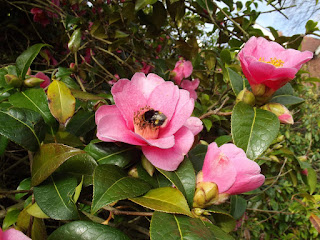Monday, 10 June 2013
Loppers, Faith and Tea
I read with amusement a while ago that Camellias can be grown successfully in containers. Our Camellia, which has been at Springfield for decades, had grown to over 20 feet high and 10 feet wide at the last calculation and our acid soil suits it. We don’t know the variety (maybe it is a Williamsii) but it has delivered consistently for the 9 plus years we have lived here and is a mass of bright pink flowers in late winter. For us, the Camellia in full bloom is a sign that spring is on the way. In the past we have had flowers in February though this year, the late spring caused it to come into flower much later. We thought it may miss flowering this year but we were not disappointed.
However, the size of our Camellia is now history because it started to look unruly a couple of years ago and Something Had To Be Done. Today, Doc set out with the loppers and it now stands 8 feet high, diminutive compared to what it was. We are hoping it is sighing to itself: “Oh thank goodness, you have taken me in hand!” rather than “Oh help, I am dying.......”
The time to prune a Camellia is immediately after flowering so that there is enough time during the active growing season for it to form new buds for next year. However, with such a hard prune in mid June, we doubt we shall see a single flower next year. We are prepared to take the hit and hopefully, our beloved Camellia will come back rejuvenated and with increased vigour in a few years time.
According to the RHS, hard pruning and renovation is safe and reliable. I shall feed it with ericaceous feed, leaf mould and mulch with bark. With some decent rainfall (never use tap water on a Camellia) it should perk up by the end of the season. We have faith in it, we must believe it will flower again.
As I type, Doc is still trundling up and down the garden, taking the amputations to the bonfire. Whilst he had the loppers in his hand, a couple of rhododendrons received a similar treatment. I wish I could help him but my foot is still painful and I am confined to light duties.
The Camellia is related to the tea plant (Camellia Sinensis, I think), which also belongs to the Camellia family of large trees/shrubs. Doc is addicted tea and would drink it all day, every day, before food, with food, after food and between food. By the time he comes in this evening, he will be in need of a very large cuppa. It is well deserved and thoroughly appropriate under the circumstances. Better go and put the kettle on.
Subscribe to:
Post Comments (Atom)



No comments:
Post a Comment